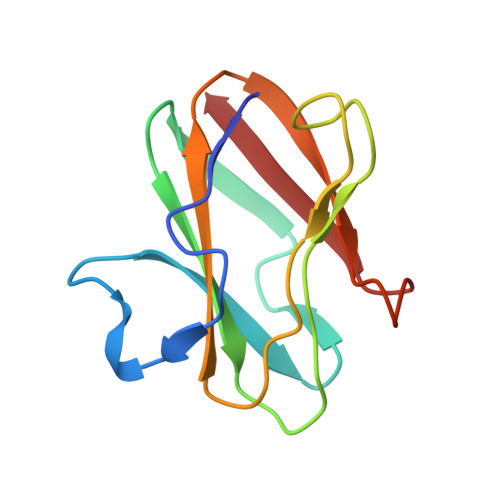Site-Directed Mutagenesis of Proline 52 To Glycine in Amicyanin Converts a True Electron Transfer Reaction into One that Is Conformationally Gated.
Ma, J.K., Carrell, C.J., Mathews, F.S., Davidson, V.L.(2006) Biochemistry 45: 8284-8293
- PubMed: 16819827
- DOI: https://doi.org/10.1021/bi0605134
- Primary Citation of Related Structures:
2GB2, 2GBA - PubMed Abstract:
Amicyanin is a type I copper protein that is the natural electron acceptor for the quinoprotein methylamine dehydrogenase (MADH). The conversion of Proline52 of amicyanin to a glycine does not alter the physical and spectroscopic properties of the copper binding site, but it does alter the rate of electron transfer (ET) from MADH. The values of electronic coupling (H(AB)) and reorganization energy (lambda) that are associated with the true ET reaction from the reduced O-quinol tryptophan tryptophylquinone (TTQ) of MADH to oxidized amicyanin are significantly altered as a consequence of the P52G mutation. The experimentally determined H(AB) increases from 12 to 78 cm(-1), and lambda increases from 2.3 to 2.8 eV. The rate and salt-dependence of the proton transfer-gated ET reaction from N-quinol MADH to amicyanin are also changed by the P52G mutation. Kinetic data suggests that a new common reaction step has become rate-limiting for both the true and gated ET reactions that occur from different redox forms of MADH. A comparison of the crystal structures of P52G amicyanin with those of native amicyanin free and in complex with MADH provided clues as to the basis for the change in ET parameters. The mutation results in the loss of three carbons from Pro52 and the movement of the neighboring residue Met51. This reduces the number of hydrophobic interactions with MADH in the complex and perturbs the protein-protein interface. A model is proposed for the ET reaction with P52G amicyanin in which the most stable conformation of the protein-protein complex with MADH is not optimal for ET. A new preceding kinetic step is introduced prior to true ET that requires P52G amicyanin to switch from this redox-inactive stable complex to a redox-active unstable complex. Thus, the ET reaction of P52G amicyanin is no longer a true ET but one that is conformationally gated by the reorientation of the proteins within the ET protein complex. This same reaction step now also gates the ET from N-quinol MADH, which is normally rate-limited by a proton transfer.
Organizational Affiliation:
Department of Biochemistry, The University of Mississippi Medical Center, Jackson, Mississippi 39216-4505, USA.















